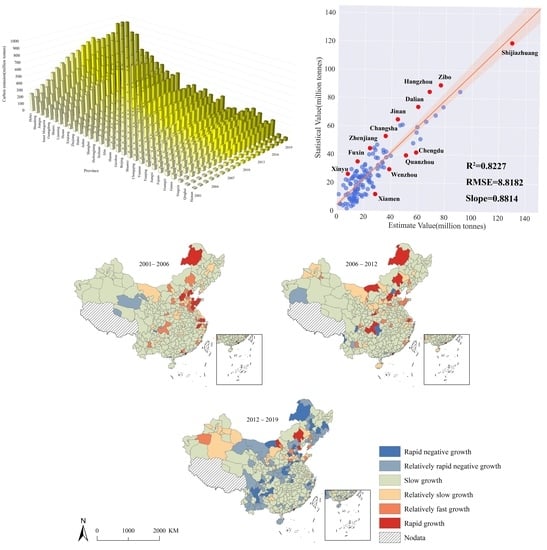Carbon Emissions Estimation and Spatiotemporal Analysis of China at City Level Based on Multi-Dimensional Data and Machine Learning
Abstract
:1. Introduction
2. Materials and Methods
2.1. Study Area
2.2. Data Source and Preprocessing
2.2.1. Land Use
2.2.2. Land Surface Temperature
2.2.3. Nighttime Light
2.2.4. Added-Value Secondary Industry
2.3. Machine-Learning Algorithms
2.3.1. Multiple Linear Regression
2.3.2. Random Forest
2.3.3. Deep Neural Network Ensemble
2.4. Analysis of the Spatiotemporal Characteristics of Carbon Emissions
2.4.1. Linear Trend Analysis
2.4.2. Standard Deviational Ellipse
3. Results and Discussion
3.1. Model Selection and Application
3.1.1. Model Comparison
3.1.2. Model Application and Evaluation
3.2. Spatiotemporal Characteristics of Carbon Emissions from 2001–2019
3.2.1. Linear Trend Analysis
3.2.2. Standard Deviational Ellipse
3.3. Discussion
4. Conclusions
Author Contributions
Funding
Data Availability Statement
Conflicts of Interest
References
- Antonakakis, N.; Chatziantoniou, I.; Filis, G. Energy consumption, CO2 emissions, and economic growth: An ethical dilemma. Renew. Sust. Energy Rev. 2017, 68, 808–824. [Google Scholar] [CrossRef] [Green Version]
- Wang, P.; Lin, C.; Wang, Y.; Liu, D.; Song, D.; Wu, T. Location-specific co-benefits of carbon emissions reduction from coal-fired power plants in China. Nat. Commun. 2021, 12, 6948. [Google Scholar] [CrossRef] [PubMed]
- Yang, Z.; Yuan, Y.; Zhang, Q. Carbon emission trading Scheme, carbon emissions reduction and spatial spillover effects: Quasi-experimental evidence from China. Front. Environ. Sci. 2022, 9, 684. [Google Scholar] [CrossRef]
- Liu, Z.; Guan, D.; Moore, S.; Lee, H.; Su, J.; Zhang, Q. Steps to China’s carbon peak. Nature 2015, 522, 279–281. [Google Scholar] [CrossRef] [Green Version]
- Xu, G.; Schwarz, P.; Yang, H. Adjusting energy consumption structure to achieve China’s CO2 emissions peak. Renew. Sust. Energy Rev. 2020, 122, 109737. [Google Scholar] [CrossRef]
- Qin, H.; Huang, Q.; Zhang, Z.; Lu, Y.; Li, M.; Xu, L.; Chen, Z. Carbon dioxide emission driving factors analysis and policy implications of Chinese cities: Combining geographically weighted regression with two-step cluster. Sci. Total Environ. 2019, 684, 413–424. [Google Scholar] [CrossRef]
- Liu, H.; Ma, L.; Xu, L. Estimating spatiotemporal dynamics of county-level fossil fuel consumption based on integrated nighttime light data. J. Clean. Prod. 2021, 278, 123427. [Google Scholar] [CrossRef]
- Wang, M.; Feng, C. Decomposition of energy-related CO2 emissions in China: An empirical analysis based on provincial panel data of three sectors. Appl. Energy 2017, 190, 772–787. [Google Scholar] [CrossRef]
- Wang, P.; Wu, W.; Zhu, B.; Wei, Y. Examining the impact factors of energy-related CO2 emissions using the STIRPAT model in Guangdong Province, China. Appl. Energy 2013, 106, 65–71. [Google Scholar] [CrossRef]
- Chen, L.; Yang, Z. A spatio-temporal decomposition analysis of energy-related CO2 emission growth in China. J. Clean. Prod. 2015, 103, 49–60. [Google Scholar] [CrossRef]
- Wang, S.; Fang, C.; Guan, X.; Pang, B.; Ma, H. Urbanisation, energy consumption, and carbon dioxide emissions in China: A panel data analysis of China’s provinces. Appl. Energy 2014, 136, 738–749. [Google Scholar] [CrossRef]
- Wang, S.; Zhou, C.; Li, G.; Feng, K. CO2, economic growth, and energy consumption in China’s provinces: Investigating the spatiotemporal and econometric characteristics of China’s CO2 emissions. Ecol. Indic. 2016, 69, 184–195. [Google Scholar] [CrossRef]
- Shi, K.; Yu, B.; Huang, Y.; Hu, Y.; Yin, B.; Chen, Z.; Chen, L.; Wu, J. Evaluating the Ability of NPP-VIIRS Nighttime Light Data to Estimate the Gross Domestic Product and the Electric Power Consumption of China at Multiple Scales: A Comparison with DMSP-OLS Data. Remote Sens. 2014, 6, 1705–1724. [Google Scholar] [CrossRef] [Green Version]
- Xie, Y.; Weng, Q. World energy consumption pattern as revealed by DMSP-OLS nighttime light imagery. Gisci. Remote Sens. 2016, 53, 265–282. [Google Scholar] [CrossRef]
- Cao, X.; Wang, J.; Chen, J.; Shi, F. Spatialization of electricity consumption of China using saturation-corrected DMSP-OLS data. Int. J. Appl. Earth Obs. 2014, 28, 193–200. [Google Scholar] [CrossRef]
- Zheng, Y.; He, Y.; Zhou, Q.; Wang, H. Quantitative evaluation of urban expansion using NPP-VIIRS nighttime light and landsat spectral data. Sustain. Cities Soc. 2022, 76, 103338. [Google Scholar] [CrossRef]
- Du, X.; Shen, L.; Wong, S.W.; Meng, C.; Yang, Z. Night-time light data based decoupling relationship analysis between economic growth and carbon emission in 289 Chinese cities. Sustain. Cities Soc. 2021, 73, 103119. [Google Scholar] [CrossRef]
- Yu, B.; Shi, K.; Hu, Y.; Huang, C.; Chen, Z.; Wu, J. Poverty evaluation using NPP-VIIRS nighttime light composite data at the county level in China. IEEE J. Sel. Top. Appl. Earth Obs. Remote Sens. 2015, 8, 1217–1229. [Google Scholar] [CrossRef]
- Luo, P.; Zhang, X.; Cheng, J.; Sun, Q. Modeling population density using a new index derived from multi-sensor image data. Remote Sens. 2019, 11, 2620. [Google Scholar] [CrossRef] [Green Version]
- Meng, X.; Han, J.; Huang, C. An improved vegetation adjusted nighttime light urban index and its application in quantifying spatiotemporal dynamics of carbon emissions in China. Remote Sens. 2017, 9, 829. [Google Scholar] [CrossRef] [Green Version]
- Yue, Y.; Tian, L.; Yue, Q.; Wang, Z. Spatiotemporal variations in energy consumption and their influencing factors in China based on the integration of the DMSP-OLS and NPP-VIIRS nighttime light datasets. Remote Sens. 2020, 12, 1151. [Google Scholar] [CrossRef] [Green Version]
- Sun, Y.; Zheng, S.; Wu, Y.; Schlink, U.; Singh, R.P. Spatiotemporal variations of city-level carbon emissions in China during 2000–2017 using nighttime light data. Remote Sens. 2020, 12, 2916. [Google Scholar] [CrossRef]
- Elvidge, C.; Baugh, K.; Kihn, E.; Kroehl, H.; Davis, E.; Davis, C. Relation between satellite observed visible-near infrared emissions, population, economic activity and electric power consumption. Int. J. Remote Sens. 1997, 18, 1373–1379. [Google Scholar] [CrossRef]
- Shi, K.; Chen, Y.; Yu, B.; Xu, T.; Chen, Z.; Liu, R.; Li, L.; Wu, J. Modeling spatiotemporal CO2 (carbon dioxide) emission dynamics in China from DMSP-OLS nighttime stable light data using panel data analysis. Appl. Energy 2016, 168, 523–533. [Google Scholar] [CrossRef]
- Zhong, L.; Liu, X.; Ao, J. Spatiotemporal dynamics evaluation of pixel-level gross domestic product, electric power consumption, and carbon emissions in countries along the belt and road. Energy 2022, 239, 121841. [Google Scholar] [CrossRef]
- Lv, Q.; Liu, H.; Wang, J.; Liu, H.; Shang, Y. Multiscale analysis on spatiotemporal dynamics of energy consumption CO2 emissions in China: Utilizing the integrated of DMSP-OLS and NPP-VIIRS nighttime light datasets. Sci. Total Environ. 2020, 703, 134394. [Google Scholar] [CrossRef]
- Shi, K.; Chen, Z.; Cui, Y.; Wu, J.; Yu, B. NPP-VIIRS nighttime light data have different correlated relationships with fossil fuel combustion carbon emissions from different sectors. IEEE Geosci. Remote Sens. Lett. 2021, 18, 2062–2066. [Google Scholar] [CrossRef]
- Wu, Y.; Li, C.; Shi, K.; Liu, S.; Chang, Z. Exploring the effect of urban sprawl on carbon dioxide emissions: An urban sprawl model analysis from remotely sensed nighttime light data. Environ. Impact Assess. Rev. 2022, 93, 106731. [Google Scholar] [CrossRef]
- Ding, J.; Chen, B.; Liu, H.; Huang, M. Convolutional neural network with data augmentation for SAR target recognition. IEEE Geosci. Remote Sens. Lett. 2016, 13, 364–368. [Google Scholar] [CrossRef]
- Yang, M.; Tseng, H.; Hsu, Y.; Tsai, H.P. Semantic segmentation using deep learning with vegetation indices for rice lodging identification in multi-date UAV visible images. Remote Sens. 2020, 12, 633. [Google Scholar] [CrossRef] [Green Version]
- Wang, Y.; Li, Z.; Zeng, C.; Xia, G.; Shen, H. An urban water extraction method combining deep learning and Google Earth Engine. IEEE J. Sel. Top. Appl. Earth Obs. Remote Sens. 2020, 13, 768–781. [Google Scholar] [CrossRef]
- Yang, D.; Luan, W.; Qiao, L.; Pratama, M. Modeling and spatio-temporal analysis of city-level carbon emissions based on nighttime light satellite imagery. Appl. Energy 2020, 268, 114696. [Google Scholar] [CrossRef]
- Shan, Y.; Guan, D.; Zheng, H.; Ou, J.; Li, Y.; Meng, J.; Mi, Z.; Liu, Z.; Zhang, Q. Data descriptor: China CO2 emission accounts 1997–2015. Sci. Data 2018, 5, 170201. [Google Scholar] [CrossRef] [Green Version]
- Rong, T.; Zhang, P.; Jing, W.; Zhang, Y.; Li, Y.; Yang, D.; Yang, J.; Chang, H.; Ge, L. Carbon dioxide emissions and their driving forces of land use change based on economic contributive coefficient (ECC) and ecological support coefficient (ESC) in the lower Yellow River region (1995-2018). Energies 2020, 13, 2600. [Google Scholar] [CrossRef]
- Zhou, Y.; Chen, M.; Tang, Z.; Mei, Z. Urbanization, land use change, and carbon emissions: Quantitative assessments for city-level carbon emissions in Beijing-Tianjin-Hebei region. Sustain. Cities Soc. 2021, 66, 102701. [Google Scholar] [CrossRef]
- Rosenzweig, C.; Solecki, W.; Hammer, S.A.; Mehrotra, S. Cities lead the way in climate-change action. Nature 2010, 467, 909–911. [Google Scholar] [CrossRef]
- Zhao, Z.; Yang, X.; Yan, H.; Huang, Y.; Zhang, G.; Lin, T.; Ye, H. Downscaling building energy consumption carbon emissions by machine learning. Remote Sens. 2021, 13, 4346. [Google Scholar] [CrossRef]
- Ma, J.; Guo, J.; Ahmad, S.; Li, Z.; Hong, J. Constructing a new inter-calibration method for DMSP-OLS and NPP-VIIRS nighttime light. Remote Sens. 2020, 12, 937. [Google Scholar] [CrossRef] [Green Version]
- Elvidge, C.D.; Ziskin, D.; Baugh, K.E.; Tuttle, B.T.; Ghosh, T.; Pack, D.W.; Erwin, E.H.; Zhizhin, M. A fifteen year record of global natural gas flaring derived from satellite data. Energies 2009, 2, 595–622. [Google Scholar] [CrossRef]
- Shi, K.; Shen, J.; Wu, Y.; Liu, S.; Li, L. Carbon dioxide (CO2) emissions from the service industry, traffic, and secondary industry as revealed by the remotely sensed nighttime light data. Int. J. Digit. Earth 2021, 14, 1514–1527. [Google Scholar] [CrossRef]
- Yeo, I.; Johnson, R. A new family of power transformations to improve normality or symmetry. Biometrika 2000, 87, 954–959. [Google Scholar] [CrossRef]
- McCulloch, C. Generalized linear models. J. Am. Stat. Assoc. 2000, 95, 1320–1324. [Google Scholar] [CrossRef]
- Breiman, L. Random forests. Mach. Learn. 2001, 45, 5–32. [Google Scholar] [CrossRef] [Green Version]
- Geurts, P.; Ernst, D.; Wehenkel, L. Extremely randomized trees. Mach. Learn. 2006, 63, 3–42. [Google Scholar] [CrossRef] [Green Version]
- Breiman, L. Bagging predictors. Mach. Learn. 1996, 24, 123–140. [Google Scholar] [CrossRef] [Green Version]
- Maimaitijiang, M.; Sagan, V.; Sidike, P.; Hartling, S.; Esposito, F.; Fritschi, F.B. Soybean yield prediction from UAV using multimodal data fusion and deep learning. Remote Sens. Environ. 2020, 237, 111599. [Google Scholar] [CrossRef]
- Pan, X.; Zhang, C.; Xu, J.; Zhao, J. Simplified object-based deep neural network for very high resolution remote sensing image classification. ISPRS J. Photogramm. Remote Sens. 2021, 181, 218–237. [Google Scholar] [CrossRef]
- Hinton, G.E.; Osindero, S.; Teh, Y. A fast learning algorithm for deep belief nets. Neural Comput. 2006, 18, 1527–1554. [Google Scholar] [CrossRef]
- Hornik, K.; Stinchcombe, M.; White, H. Multilayer feedforward networks are universal approximators. Neural Netw. 1989, 2, 359–366. [Google Scholar] [CrossRef]
- Dong, X.; Li, Y.; Zhong, T.; Wu, N.; Wang, H. Random and coherent noise suppression in DAS-VSP data by using a supervised deep learning method. IEEE Geosci. Remote Sens. Lett. 2020, 19, 8001605. [Google Scholar] [CrossRef]
- Kingma, D.P.; Ba, J. Adam: A method for stochastic optimization. In Proceedings of the 3rd International Conference on Learning Representations, San Diego, CA, USA, 7–9 May 2015. [Google Scholar]
- Wang, S.; Fan, F. Analysis of the response of long-term vegetation dynamics to climate variability using the pruned exact linear time (PELT) method and disturbance lag model (DLM) based on remote sensing data: A case study in Guangdong province (China). Remote Sens. 2021, 13, 1873. [Google Scholar] [CrossRef]
- Yuill, R.S. The Standard Deviational Ellipse; An updated tool for spatial description. Geogr. Ann. Ser. B Hum. Geogr. 1971, 53, 28–39. [Google Scholar] [CrossRef]
- Carpio, A.; Ponce-Lopez, R.; Lozano-Garcia, D.F. Urban form, land use, and cover change and their impact on carbon emissions in the Monterrey Metropolitan area, Mexico. Urban Clim. 2021, 39, 100947. [Google Scholar] [CrossRef]
- Shan, Y.; Liu, J.; Liu, Z.; Shao, S.; Guan, D. An emissions-socioeconomic inventory of Chinese cities. Sci. Data. 2019, 6, 190027. [Google Scholar] [CrossRef] [PubMed] [Green Version]
- Lo, K.; Wang, M.Y. Energy conservation in China’s Twelfth Five-Year Plan period: Continuation or paradigm shift? Renew. Sust. Energy Rev. 2013, 18, 499–507. [Google Scholar] [CrossRef]
- Wang, L.; Zhang, F.; Pilot, E.; Yu, J.; Nie, C.; Holdaway, J.; Yang, L.; Li, Y.; Wang, W.; Vardoulakis, S.; et al. Taking Action on Air Pollution Control in the Beijing-Tianjin-Hebei (BTH) Region: Progress, Challenges and Opportunities. Int. J. Environ. Res. Public Health 2018, 15, 306. [Google Scholar] [CrossRef] [Green Version]
- Zhao, J.; Ji, G.; Yue, Y.; Lai, Z.; Chen, Y.; Yang, D. Spatio-temporal dynamics of urban residential CO2 emissions and their driving forces in China using the integrated two nighttime light datasets. Appl. Energy 2019, 235, 612–624. [Google Scholar] [CrossRef]

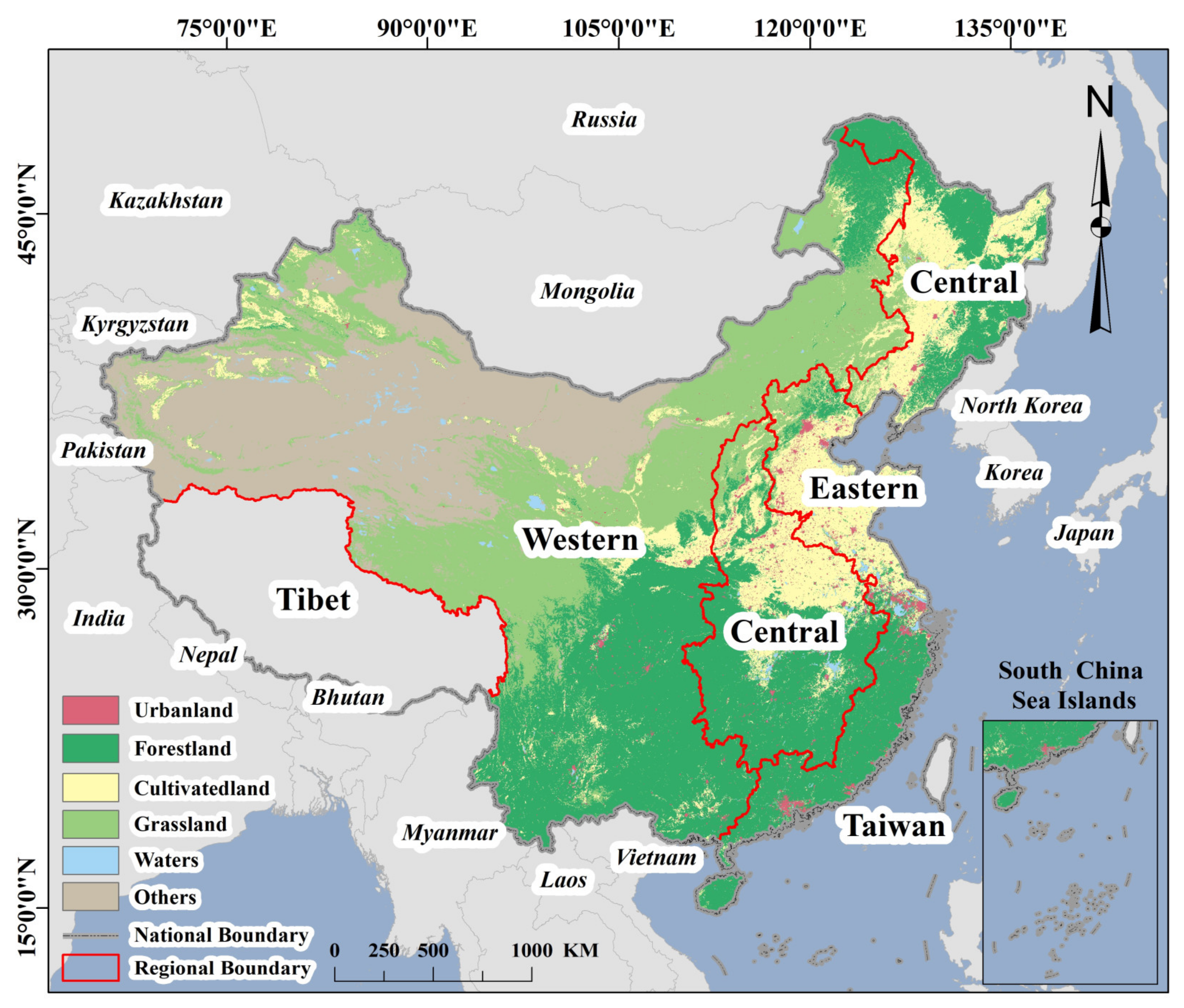

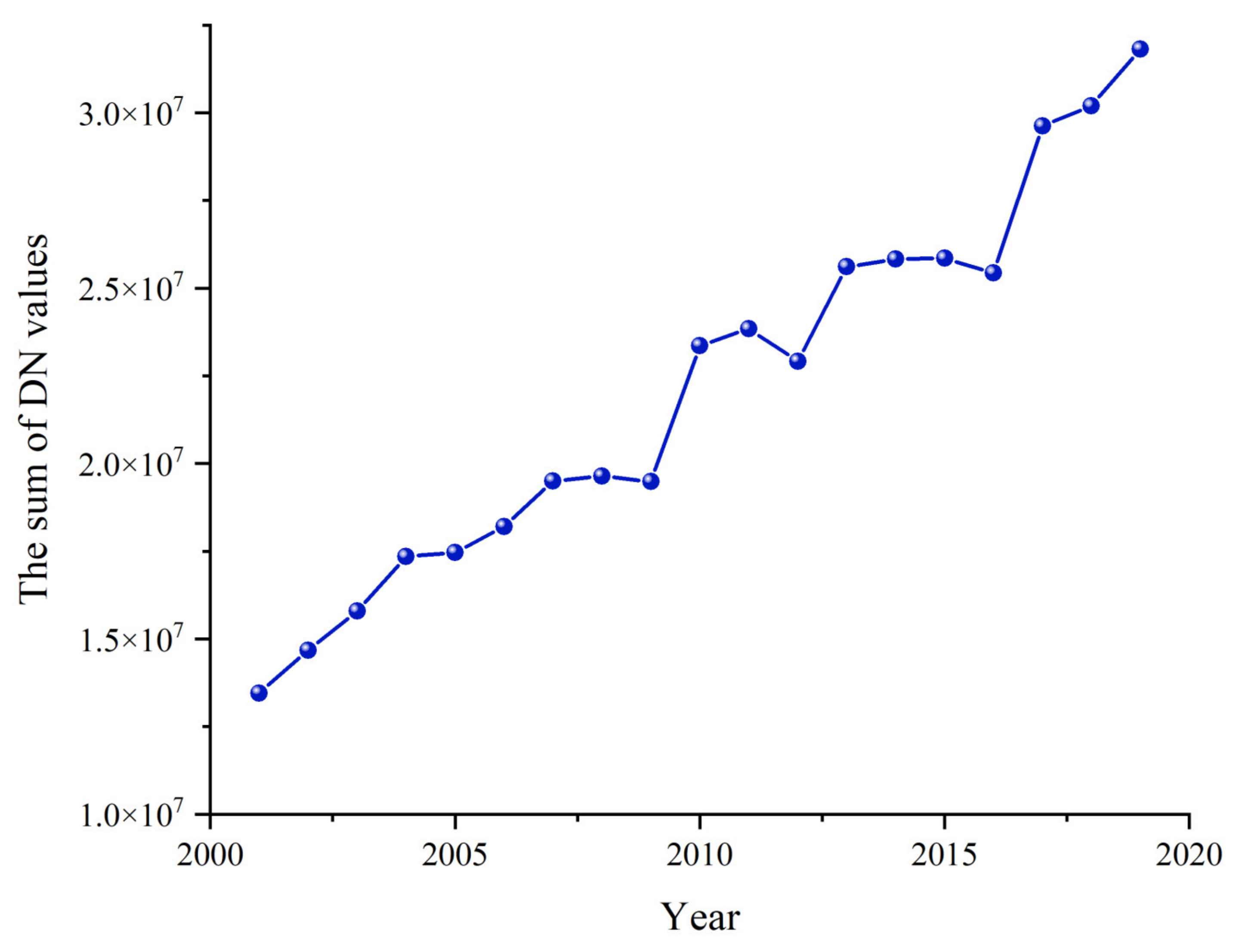

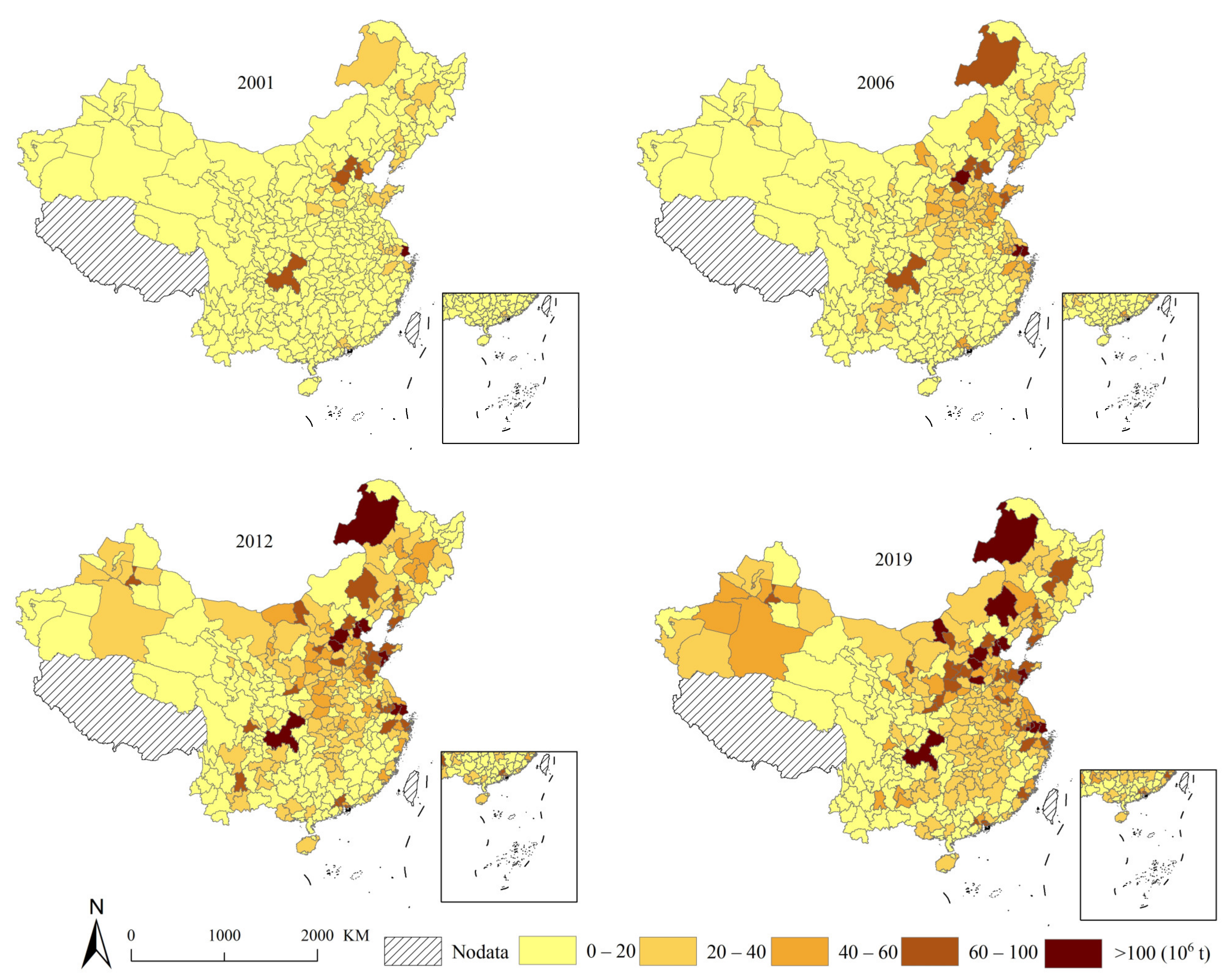
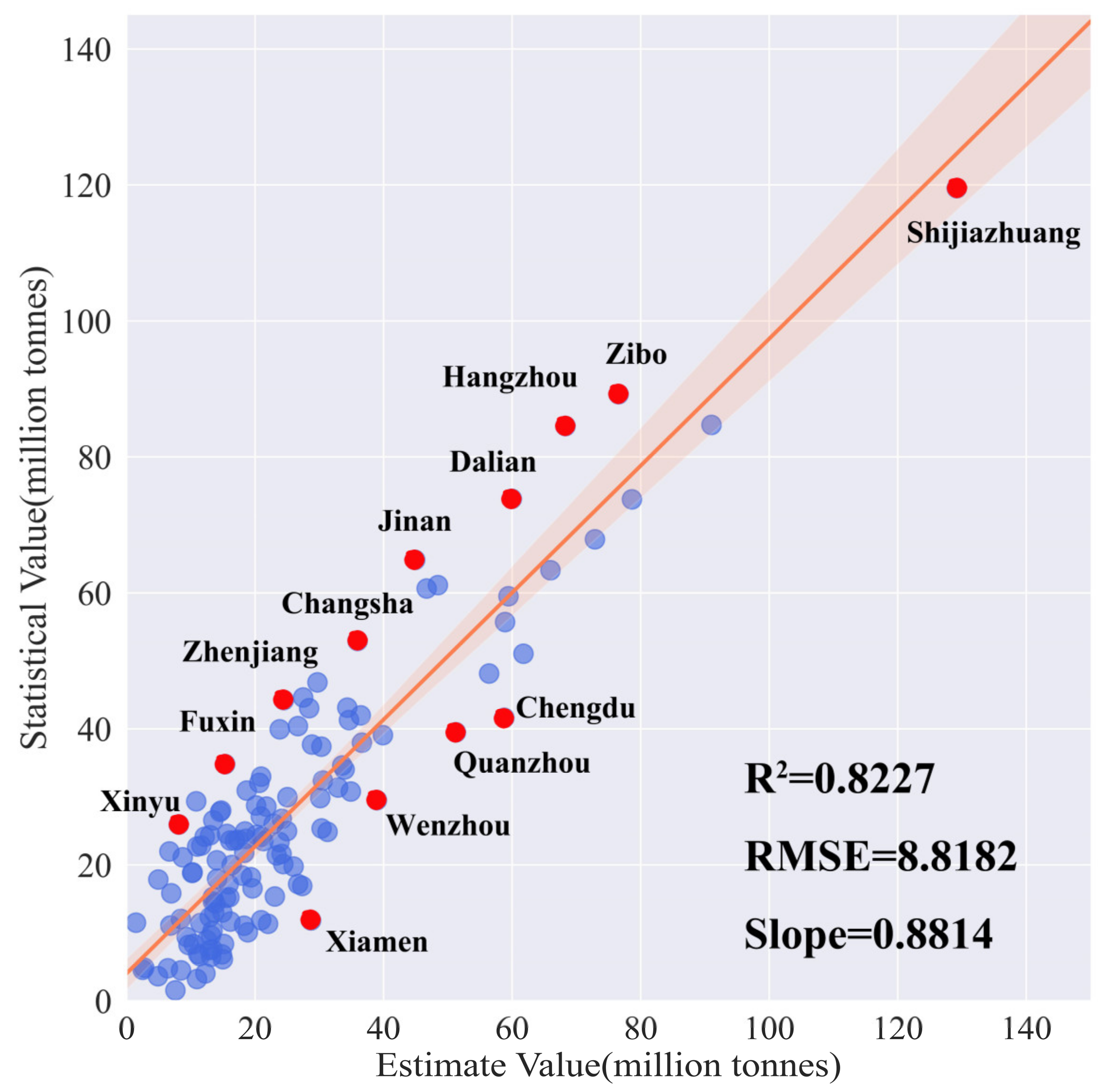
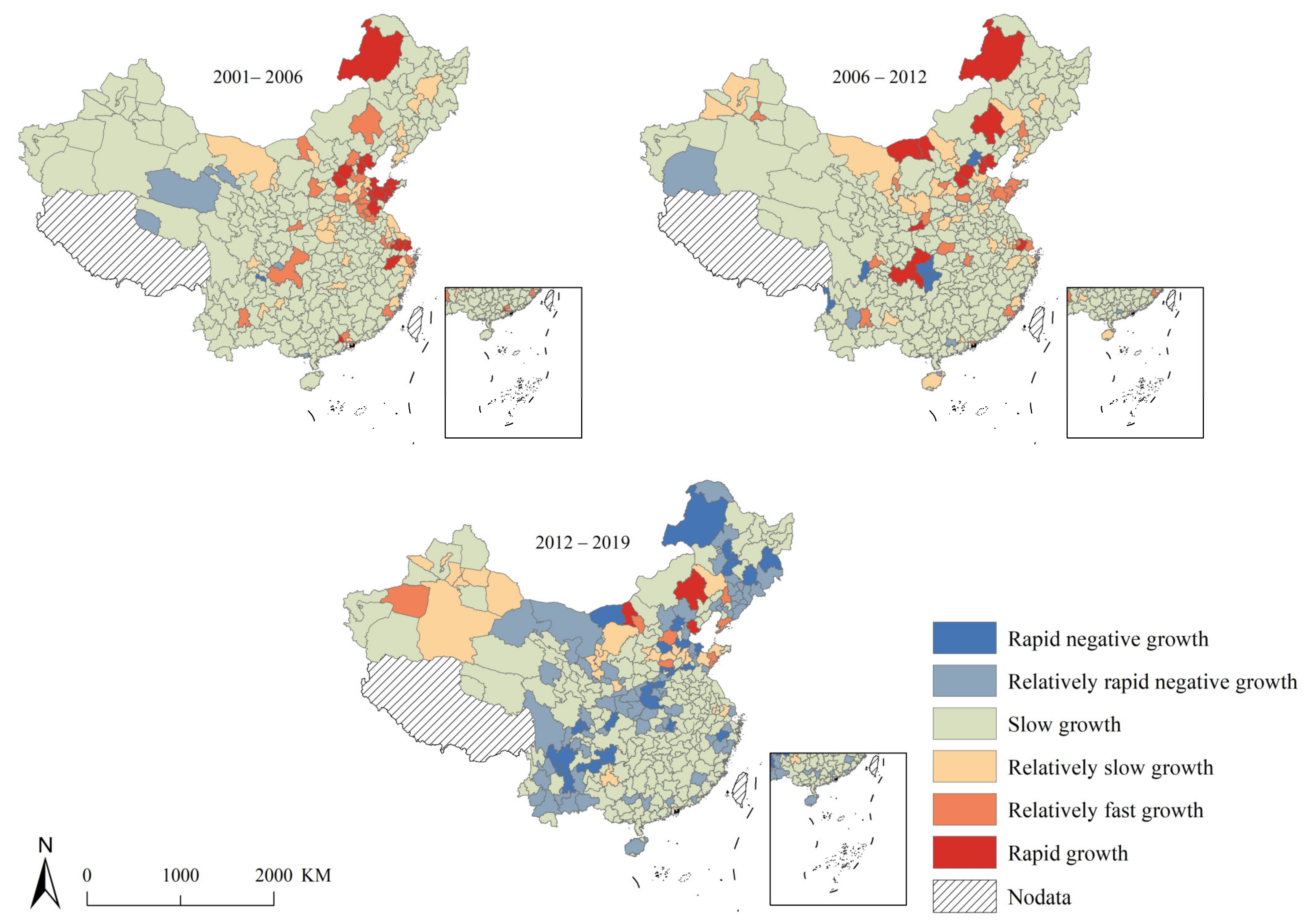
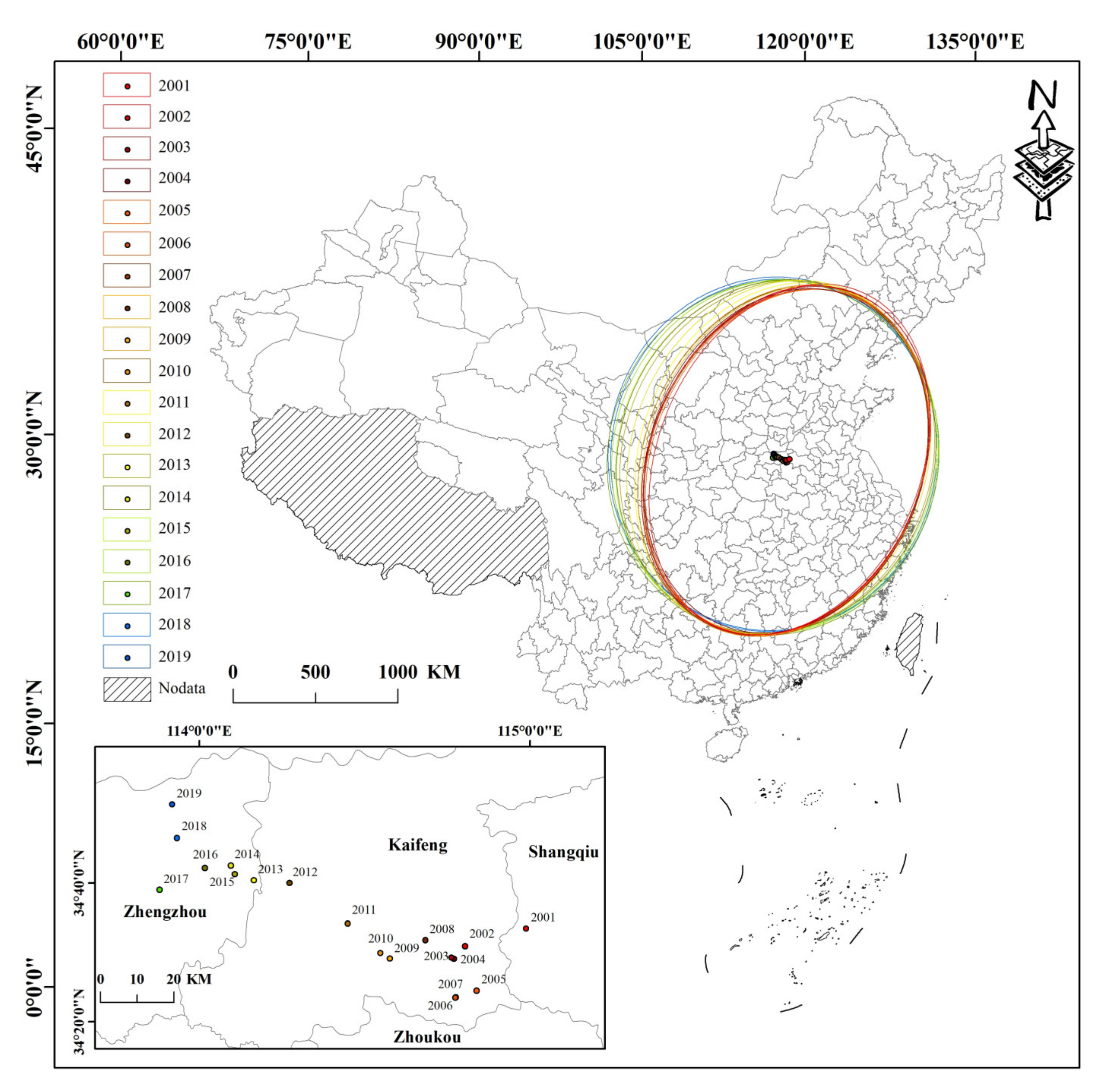

| Data | Data Description | Time Interval | Source |
|---|---|---|---|
| DMSP-OLS | Annual DMSP-OLS nighttime stable light data with a spatial resolution of 1 km × 1 km | 2001–2013 | NOAA (https://ngdc.noaa.gov/eog/dmsp/downloadV4composites.html (accessed on 26 January 2020)) |
| NPP-VIIRS | Monthly NPP-VIIRS nighttime light data with a spatial resolution of 0.75 km × 0.75 km | 2012–2019 | EOG (https://eogdata.mines.edu/nighttime_light/monthly/v10/ (accessed on 26 January 2020)) |
| Land use | Derived using the supervised classification of MODIS Terra and Aqua reflectance data at a spatial resolution of 0.5 km × 0.5 km | 2001–2019 | NASA (https://lpdaac.usgs.gov/products/mcd12q1v006 (accessed on 19 January 2022)) |
| Land surface temperature | Provides 8-day average surface temperature with a resolution of 1 km × 1 km | 2001–2019 | NASA (https://lpdaac.usgs.gov/products/mod11a2v006 (accessed on 29 December 2021)) |
| Boundaries | Shapefile of province-level and city-level regions | 2015 | Resource and Environmental Science and Data Center (https://www.resdc.cn (accessed on 15 July 2021)) |
| Added value of secondary industry | The unit output value-added value of the secondary industry in a certain period | 2001–2019 | China Statistical Yearbook (http://www.stats.gov.cn (accessed on 19 December 2021)) |
| Carbon emission statistics | Total carbon emissions of energy consumption in 30 provinces in the study area | 2001–2019 | Carbon Emission Accounts and Datasets (https://www.ceads.net.cn (accessed on 19 October 2021)) |
| Growth Type | Rapid Negative Growth | Relatively Rapid Negative Growth | Slow Growth |
|---|---|---|---|
| Slope | <k − s | K − s ~ 0 | 0 ~ k + 0.5 s |
| Growth type | Relatively slow growth | Relatively fast growth | Rapid growth |
| Slope | k + 0.5 s ~ k + s | k + s ~ k + 2 s | >k + 2 s |
| Training Set | Test Set | |||||
|---|---|---|---|---|---|---|
| Study Area | Methods | R2 | RMSE | R2 | RMSE | Time |
| Eastern | MLR | 0.8549 | 91.1901 | 0.8319 | 106.5336 | 5 S |
| RF | 0.9646 | 46.3780 | 0.9356 | 55.2019 | 438 S | |
| DNNE | 0.9959 | 14.9305 | 0.9899 | 22.6544 | 445 S | |
| Central | MLR | 0.7231 | 65.4376 | 0.5863 | 79.6208 | 5 S |
| RF | 0.9390 | 31.0839 | 0.8936 | 40.3151 | 423 S | |
| DNNE | 0.9901 | 11.1858 | 0.9901 | 12.2030 | 424 S | |
| Western | MLR | 0.6344 | 81.6179 | 0.5284 | 96.3817 | 5 S |
| RF | 0.8869 | 45.1309 | 0.7957 | 56.8278 | 430 S | |
| DNNE | 0.9939 | 10.6804 | 0.9786 | 13.8629 | 433 S | |
| LU | AVSI | NTL | LST | |
|---|---|---|---|---|
| Eastern | 0.31 | 0.32 | 0.21 | 0.16 |
| Central | 0.27 | 0.33 | 0.20 | 0.20 |
| Western | 0.34 | 0.27 | 0.27 | 0.12 |
| City | AVSI | AVTI | LU | LST | NTL | TCO2 | RCO2 | CCO2 | DCO2 | PCO2 | ESGDP |
|---|---|---|---|---|---|---|---|---|---|---|---|
| Shijiazhuang | 1653.92 | 1377.75 | 1551.00 | 20.22 | 158809.21 | 119.54 | 60.06 | 10.76 | 3.32 | 25.86 | 1.49 |
| Quanzhou | 2145.03 | 1287.55 | 1409.00 | 23.66 | 140489.69 | 39.52 | 15.11 | 2.14 | 4.34 | - | 0.78 |
| Wenzhou | 1535.12 | 1297.66 | 717.00 | 20.96 | 109532.03 | 29.54 | 22.86 | 0.06 | 2.47 | 0.13 | 0.59 |
| Xiamen | 1026.86 | 1003.88 | 443.00 | 25.23 | 47943.50 | 11.85 | 6.82 | - | 1.61 | - | 0.57 |
| Chengdu | 2480.90 | 2785.30 | 1303.00 | 19.79 | 173981.74 | 41.63 | 11.58 | 3.21 | 5.14 | 5.96 | 0.72 |
| Zibo | 1766.57 | 994.88 | 885.00 | 19.79 | 91561.24 | 89.20 | 42.80 | 7.10 | 4.10 | 11.10 | 1.62 |
| Hangzhou | 2844.47 | 2893.39 | 1409.00 | 20.16 | 177833.43 | 84.56 | 54.88 | 4.02 | 4.39 | 10.21 | 0.68 |
| Dalian | 2645.50 | 2167.50 | 741.00 | 15.23 | 117448.16 | 73.86 | 34.93 | 0.77 | 9.47 | 6.43 | 0.87 |
| Jinan | 1637.45 | 2058.18 | 503.00 | 19.38 | 121026.15 | 64.88 | 20.28 | 13.04 | 4.76 | 4.78 | 1.00 |
| Changsha | 2437.03 | 1908.02 | 498.00 | 22.12 | 89807.55 | 52.97 | 12.30 | 15.56 | 2.74 | 10.32 | 0.83 |
| Zhenjiang | 1124.52 | 750.54 | 395.00 | 20.27 | 85290.35 | 44.24 | 33.31 | 1.81 | 1.01 | 5.47 | 0.80 |
| Fuxin | 148.70 | 119.70 | 171.00 | 15.93 | 33823.06 | 34.82 | 30.56 | 0.68 | 0.69 | 0.69 | - |
| Xinyu | 403.36 | 189.98 | 88.00 | 23.20 | 17229.25 | 29.40 | 8.00 | 10.60 | 0.80 | 1.20 | 2.69 |
Publisher’s Note: MDPI stays neutral with regard to jurisdictional claims in published maps and institutional affiliations. |
© 2022 by the authors. Licensee MDPI, Basel, Switzerland. This article is an open access article distributed under the terms and conditions of the Creative Commons Attribution (CC BY) license (https://creativecommons.org/licenses/by/4.0/).
Share and Cite
Lin, X.; Ma, J.; Chen, H.; Shen, F.; Ahmad, S.; Li, Z. Carbon Emissions Estimation and Spatiotemporal Analysis of China at City Level Based on Multi-Dimensional Data and Machine Learning. Remote Sens. 2022, 14, 3014. https://doi.org/10.3390/rs14133014
Lin X, Ma J, Chen H, Shen F, Ahmad S, Li Z. Carbon Emissions Estimation and Spatiotemporal Analysis of China at City Level Based on Multi-Dimensional Data and Machine Learning. Remote Sensing. 2022; 14(13):3014. https://doi.org/10.3390/rs14133014
Chicago/Turabian StyleLin, Xiwen, Jinji Ma, Hao Chen, Fei Shen, Safura Ahmad, and Zhengqiang Li. 2022. "Carbon Emissions Estimation and Spatiotemporal Analysis of China at City Level Based on Multi-Dimensional Data and Machine Learning" Remote Sensing 14, no. 13: 3014. https://doi.org/10.3390/rs14133014
APA StyleLin, X., Ma, J., Chen, H., Shen, F., Ahmad, S., & Li, Z. (2022). Carbon Emissions Estimation and Spatiotemporal Analysis of China at City Level Based on Multi-Dimensional Data and Machine Learning. Remote Sensing, 14(13), 3014. https://doi.org/10.3390/rs14133014






